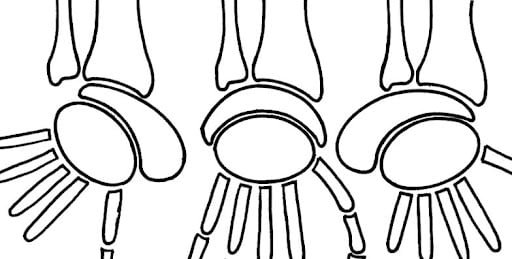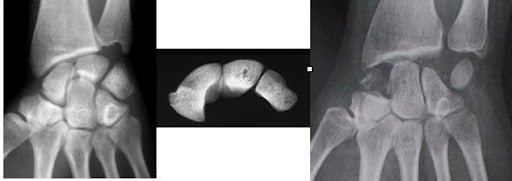DEFINITION
Osteoarthritis of the wrist is a condition in which the wrist joints are affected by the progressive deterioration of the cartilage covering the joint surfaces. This deterioration can lead to pain, stiffness, reduced mobility and inflammation of the wrist joints. Osteoarthritis of the wrist may result from normal age-related wear and tear, previous trauma, overuse of the wrist or other factors.
TREATMENTS
Surgical treatments for osteoarthritis of the wrist vary depending on the severity of the condition and the symptoms experienced by the patient. Here are some common surgical options for treating osteoarthritis of the wrist:
- First row carpal resection: This procedure involves the removal of damaged bones in the first row of the carpus, which can relieve pain and improve wrist function.
- Wrist arthrodesis: Arthrodesis involves fusing the wrist bones together, creating immobility of the joint. This may relieve pain by eliminating painful movement, but it also limits wrist mobility.
- Wrist prosthesis: In some severe cases of osteoarthritis of the wrist, a joint prosthesis can be used to replace the damaged joint with artificial components.
- Joint debridement surgery: This procedure involves the cleaning and removal of inflammatory or damaged tissue in the wrist joint.
- Wrist osteotomy: This procedure involves repositioning the wrist bones to redistribute forces across the joint, reducing pain and improving function.
- Denervation surgery: This procedure aims to remove or cut the nerves that transmit pain, thus reducing painful sensations in the wrist.
EXPLANATION OF RESECTION OF THE FIRST CARPAL ROW
EXPLANATIONS AT THE ZONE TO OPERATE : THE HANDLEBAR

This is the joint between the forearm and the hand. It is made up of eight bones, three of which are mobile in relation to each other, forming an intermediate part known as the first row of the carpus. It can be compared to an articulated structure similar to a meniscus, enabling it to adjust its shape to guarantee crucial stability during power grips, regardless of the different positions of the wrist.
Why intervention is necessary
THE NATURE OF THE LESIONS
Injury to your wrist is characterized by the loss of normal relationships between the various bones. The harmonious mobility between them is broken, giving way to conflicts that lead to osteoarthritis, corresponding to the progressive wearing away of the cartilage covering them. The result is pain when the wrist is moved, often with a painful cracking sensation. Reactive inflammation causes oedema (swelling).
At this stage, there is no longer any intervention that can recreate a near-normal state. A palliative “catch-up” operation is required.
THE POSSIBILITIES THERAPEUTIC POSSIBILITIES
Medical treatment
The aim of analgesic treatment is to relieve pain. It is necessary to combine :
- Prevent wear and tear by restricting or avoiding conflict-triggering movements.
- Resting the joint by using an orthosis intermittently, thus promoting resorption of the inflammatory reaction of mechanical (non-rheumatic) origin.
- Anti-inflammatory treatment: oral NSAIDs (non-steroidal anti-inflammatory drugs) or local cortisone injections. This reduces the inflammatory response, but does not prevent cartilage wear or the aggravation of osteoarthritis.
- Visco-supplementation involves injecting a lubricant into the joint. However, at wrist level, the product is rapidly absorbed, making this method less effective.
Surgical treatment
It is recommended when the above-mentioned measures prove ineffective, or in the event of poor tolerance to treatment, particularly anti-inflammatory drugs.
After discussing the advantages and disadvantages of the various palliative operations frequently performed with Dr. de Smet, you and he decided to opt for a resection of the three bones of the first row of the carpus.

At first glance, this procedure may appear “aggressive”, involving the removal of the three bones making up the first row of the carpus. The wrist is the only joint where this procedure is feasible. A new joint is formed between the radius and the large bone.
This natural “prosthesis” effectively reduces pain while maintaining mobility and grip strength.
In general, a significant improvement in pain is observed. Recovery of mobility is generally more marked than that of strength.
The nature of the lesion, the extent of pre-existing stiffness and degenerative changes influence the quality of results.
Although the presence of one or more previous wrist procedures is not a contraindication, it may lead to less favorable results.
The final result of the operation may vary, but in principle, poor results or failures, without any complications, are rare, estimated at around 5%. In such cases, arthrodesis (wrist fusion) or prosthesis may be considered.
It is important to stress that surgery is not compulsory. It offers an alternative that may provide an improvement over the natural progression of the lesion. In the best-case scenario, the lesion remains stable and tolerable. In most cases, however, the osteoarthritis and functional pain deteriorate.
ADDITIONAL TESTS
X-rays of the wrist are the fundamental and most appropriate examination for confirming the need for resection of the three bones of the first row of the carpus.
Additional examinations such as CT scans, arthroscans or MRIs allow a more precise assessment of the condition of the cartilage remaining on the articular surfaces forming the new joint.

